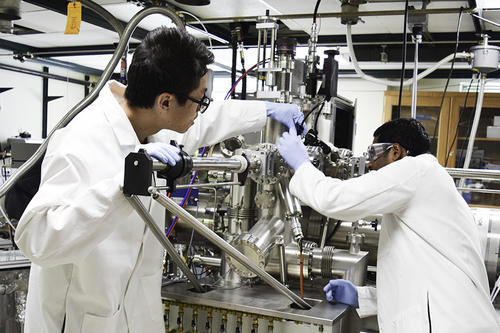
The University of Minnesota College of Science and Engineering announced that the National Science Foundation (NSF) has awarded $18 million in renewed funding over the next six years for the University’s Materials Research Science and Engineering Center (MRSEC). The University of Minnesota MRSEC program is among only 11 centers nationwide receiving funding for successful collaborative research.
This is the fourth renewal of the University of Minnesota MRSEC since its inception in 1998, with cumulative total funding exceeding $79 million from NSF. The center’s researchers conduct cutting-edge materials research that enables important areas of future technology, ranging from biomedicine and electronics to security and renewable energy.
“This continued funding is a strong affirmation of the high national stature of modern materials research at the University of Minnesota and a testament to the consistently excellent research and outreach carried out by our students, postdocs, faculty, and staff," said University of Minnesota Regents Professor Timothy Lodge, a professor in the Department of Chemistry and Department of Chemical Engineering and Materials Science who has served as the MRSEC director since 2005.
The University of Minnesota MRSEC features two interdisciplinary research groups. The first group, led by Distinguished McKnight University Professor Chris Leighton in the Department of Chemical Engineering and Materials Science, aims to access novel electronic and magnetic properties by direct application of strong local electric fields to promising new materials. This Quantum Leap-aligned research will realize extraordinary materials control, thereby enabling new approaches to low-power magnetic data storage and processing, neuro-inspired computation, and nanophotonic devices such as solar cells.
The second group, led by Professor Mahesh Mahanthappa in the Department of Chemical Engineering and Materials Science, is developing novel and systematic approaches to assembling polymeric materials into network structures with superior property combinations. These will advance multiple applications, including membranes for removal of viruses and bacteria, materials for new battery designs, therapeutic delivery platforms, and efficient photovoltaic materials.
Preparing the next generation of scientists and engineers is also a top priority for the University’s MRSEC. MRSEC investigators provide extensive research experiences for promising undergraduates from a national network of four-year colleges, minority serving institutions, and especially tribal colleges. Summer camps for high school students, drawn from the Twin Cities and from Native American communities across the upper Midwest, involve senior investigators, students, and postdoctoral fellows in hands-on laboratory activities. MRSEC also supports entertaining demonstration shows, which illustrate fundamental scientific principles to engage more than 50,000 K-12 students each year.
In addition, MRSEC has interactions with industry that involve knowledge transfer in a pre-competitive collaboration with more than 20 companies. Shared experimental facilities provide access to state-of-the-art materials characterization instrumentation to a national base of more than 500 users.
“Materials are enablers of technologies that directly affect people’s lives,” said Dr. Linda Sapochak, director of the NSF Division of Materials Research. “The MRSEC program is a flagship program for the division and with these new awards will continue its long history of forging new discoveries and fueling new technologies.”
NSF’s nationwide MRSEC program provides sustained support of interdisciplinary materials research and education of the highest quality. Founded in 1994, the MRSEC program traces its roots to the Interdisciplinary Research Laboratories established in 1960. With a program investment of nearly $350 million over six years in emerging fields such as quantum materials, synthetic biology, and artificial intelligence, MRSECs leverage diverse expertise in areas such as polymers, ceramics, and magnetic nanomaterials to forge new research endeavors driven by a vision of the materials of tomorrow.
For more information, visit the 2020 NSF MRSEC awards webpage.
- Categories:
- Science and Technology





